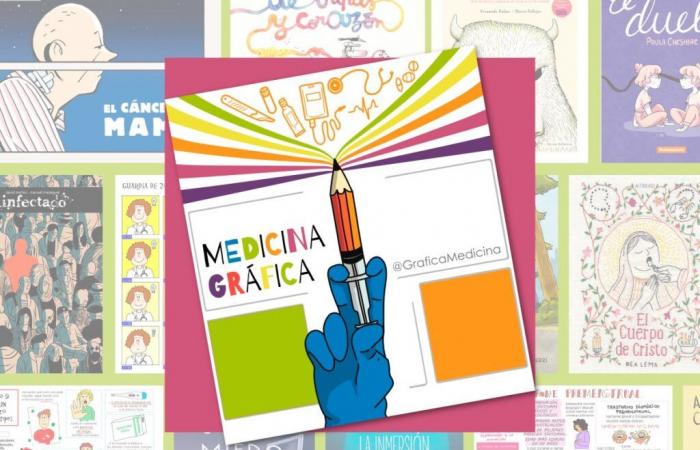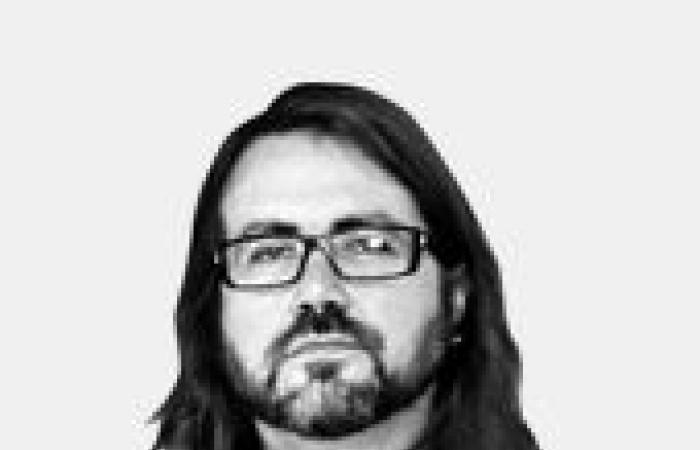Saturday, May 3, 2025, 23:12
The richness of the comic language is about to explore in many areas, but some trends make their way and fit with special strength, as is the case of graphic medicine, a movement that has come to stay and is already doing interesting fruits in the world of vignettes.
We talk about the use of comic in the Health environment, both for professionals and patients. The use of sequential art as a tool for health communication is an consummated fact, beyond the creation of lists and libraries that have numerous titles related to the subject that invite education and reflection, whether graphic novels or other formats, including illustration and graphic humor.

Graphic medicine logo and two copies
of Mónica Lalanda. R.C.

Graphic medicine logo and two copies
of Mónica Lalanda. R.C.

Logo of graphic medicine
Two specimens
by Mónica Lalanda

Logo of graphic medicine
Two specimens
by Mónica Lalanda
Something complex, arduous or difficult to explain becomes friendly material that relies on simple drawings and texts, ”explains Mónica Lalanda, coordinator of the movement for these payments. «Let’s put as an example an infographic created to explain what schizophrenia is or how the skin is taken care of if you receive radiotherapy. Besides, there are all the comics created by people who suffer from a disease, or who accompany those who suffer it, and who, dedicating themselves to the world of ninth art, decide to tell it through this medium. These comics provide incalculable value to medicine. They tell us the experience of the disease from the emotional, from experience and suffering. Just the part that hurts the most of the disease and that doctors cannot measure with any test or analysis and sometimes we do not even become aware. The toilets are reflected in their pages, often starkly and this is a great revulsive to be better communicators, more empathic. These comics can also be a great accompaniment for those who suffer a condition similar to the author. It is a very powerful material and with many possibilities ».

About Crohn’s disease

About Crohn’s disease

About Crohn’s disease

About Crohn’s disease
Graphic Medicine is a term coined in 2007 by the family doctor and author of Welsh comics Ian Williams, making explicit the potential of the comic as an exceptional way of training and communication in the health field. “The comic offers huge possibilities,” says Iñaki Gutiérrez, doctor and cartoonist, author of ‘medical notes. Distrustful drawings’, about COVID-19. «You can describe a disease with a comic, collect the experience of a disease or explore the medical-patient relationship, with the difficulties, empathies and processes that are lived in both directions. Graphic medicine has always been, although it would not have been explained or coined. The disease is an inherent part of the human being, and the comic, as an artistic manifestation, has never been alien and has reflected. Now it seems that there is a more specific niche that encourages its use consciously as training or communication ».
There is a clear boom of this current, once labeled. “Without a doubt, the comic is acquiring the place that has always corresponded to it,” says Lalanda, an emergency doctor in Castilla y León and Illustrator, a degree in Medicine from the University of Valladolid, “more and more books are published every time and those who speak of illness also grow. But the concept of graphic medicine, more than a spontaneous boom, has behind a group of passionate professionals who see in this area a step forward to improve communication ».

Mónica foographs of laland eheki Gutiérrez. R.C.

Mónica foographs of laland eheki Gutiérrez. R.C.

Mónica foographs of laland eheki Gutiérrez. R.C.

Lionla Laland Infographic Infoography and Iki Gutierrez
Since 2017, several health professionals have joined forces working with effort and altruistic way seeking, discarding, reviewing and reviewing proposals that seem useful to them (Medicinegraphic.blog). They maintain very active social networks and have organized several national congresses, in addition to setting up a Master in Graphic Medicine at the International University of Andalusia, among other academic initiatives. Officially formed as the Semgraf (Spanish Society of Graphic Medicine), they combine health with drawing.
2007
Graphic Medicine is a term coined in 2007 by the family doctor and author of Welsh comics Ian Williams.
There are artists who have told stories about the disease, either for interest or for closeness to it: Paco Roca (‘wrinkles’), Miguel Gallardo (‘Maria y I’), David Ramírez (‘Living 19 days’) … There are creators who share what has been living, such as Josune Urrutia (‘Today is not the day’) or María Hernández Martí (‘I don’t die’). For Lalanda, drawing «has always been useful to explain to patients concepts in a graphic way. But the turning point is when I dive into the world of medical ethics and discover that the material used to teach and learn is very boring and looking for other models I discover that Anglo -Saxon colleagues use a new concept for me: Graphic Medicine. I got excited. In 2016 I published the ethical code of doctors in comic format, ‘Medical Con-science’, and from there it has been a non-stop. In 2017 I decided to leave care medicine and dedicate myself only to medicine through communication. After 25 years of phoneoscope, my medical tool is now my painter ». Beyond coordinating graphic medicine movement, it is entirely dedicated to creating material for patients or health professionals, whether medical dissemination or in relation to professionalism and ethics.
“The fact that there are societies, congresses or editorials on this current, makes it more accessible and recognized, and specific works are created,” says Gutiérrez. «Many of these works do not leave the sanitary circuit, but there is more and more formative material or to share experiences for patients or relatives in comic format. As a doctor of the Public Health System of extrahospital emergencies, I work in a very specific environment that I am an exceptional witness of very critical moments for people, and also in a work environment where the term team charges an essential meaning. That is what I try to reflect in my drawings ».
Graphic medicine provides a new way and a new audience profile. “A comic can inform, you can criticize, you can make the patient outward beyond the disease, but it does so from aesthetic beauty and from the greatness of telling a story,” says Lalanda, “doctor, mother and painting” according to the biography of his Instagram profile. «In the end, we are made of stories, we like them. All these comics that we label as graphic medicine are first of all true works of art and attractive to anyone. That they are graphic medicine is just a plus ».
Gutiérrez recommends indispensable titles such as ‘To every pill’, by Josephine Mark; ‘One possibility’, by Ma Giner Bou and Cristina Durán; ‘The duel’, by Paula Cheshire, or ‘Continue drawing’, by Coco. Osakidetza invited him, at the end of last year, to give a workshop with the title “The comic as a tool for health literacy”, together with the screenwriter Koldo Azpitarte, also a doctor, and Mikel Bao. “The essay in graphic medicine is yet to come,” he says. “On the other hand, although we have advanced, there is still a way to go regarding the recognition of the comic as an adult medium for the general public.”

“Something complex, hard or difficult to explain becomes friendly material that relies on simple drawings and texts”
Mónica Lalanda
Emergency doctor in Castilla y León, Illustrator and Coordinator of Graphic Medicine
“In the near future I hope to see a lot of research in this area,” adds Lalanda. «And entry to all areas, for example, to the University, to the degrees of Health Sciences. Also its presence in medical congresses and for example, the obligation of visual abstracts in impact magazines. But for this to arrive, we still have to fight prejudices. If in the world of adults there are still a certain suspicion against the comic as a child or not serious, this is multiplied in the sanitary environment, where everything must be serious. But the important thing is to maintain scientific rigor and respect and break down barriers, with tiento, slowly. I am convinced that it is a matter of time. Comic and infographics are insurmountable means of information and dissemination ».
Greeting you is a publishing house specialized in graphic medicine, with releases such as ‘Mom cancer’, ‘A evil doctor’ or ‘living is also urgent’. What should a good “medicinal” vignette have? “Have something to tell and have the minimum visual tools to do it,” says Gutiérrez. «As to make any comic, you have to learn and know how to narrate, a minimum of graphic readability. It does not differ from knowing how to make an adventure or humor comic, unless the theme is, or specific or intentionally, health. Paco Roca did not think in terms of graphic medicine when creating ‘wrinkles’, but fits the epigraph ».
Lalanda, from her perspective as creator of content in graphic medicine, thinks that the first thing that a good work must have is “a solid base, good scientific evidence and absolute rigor. A good continent cannot justify a bad content. It must be free of conflict of interest, such as all good medical communication. Then it requires information distillation work. The documents and articles that are born must be passed through a funnel and then by a strainer to stay in information pills. The text of these pills must be clear, simple and lacking all medical jargon. These phrases must be accompanied by drawings that not only contribute aesthetically but also that they participate in clarifying ideas and simplifying concepts. They are simply essential. It should be carefully studied who is the audience to which it is addressed so that the tone is correct. A good medicine vignette has to be clear, attractive, useful and rigorous ».







